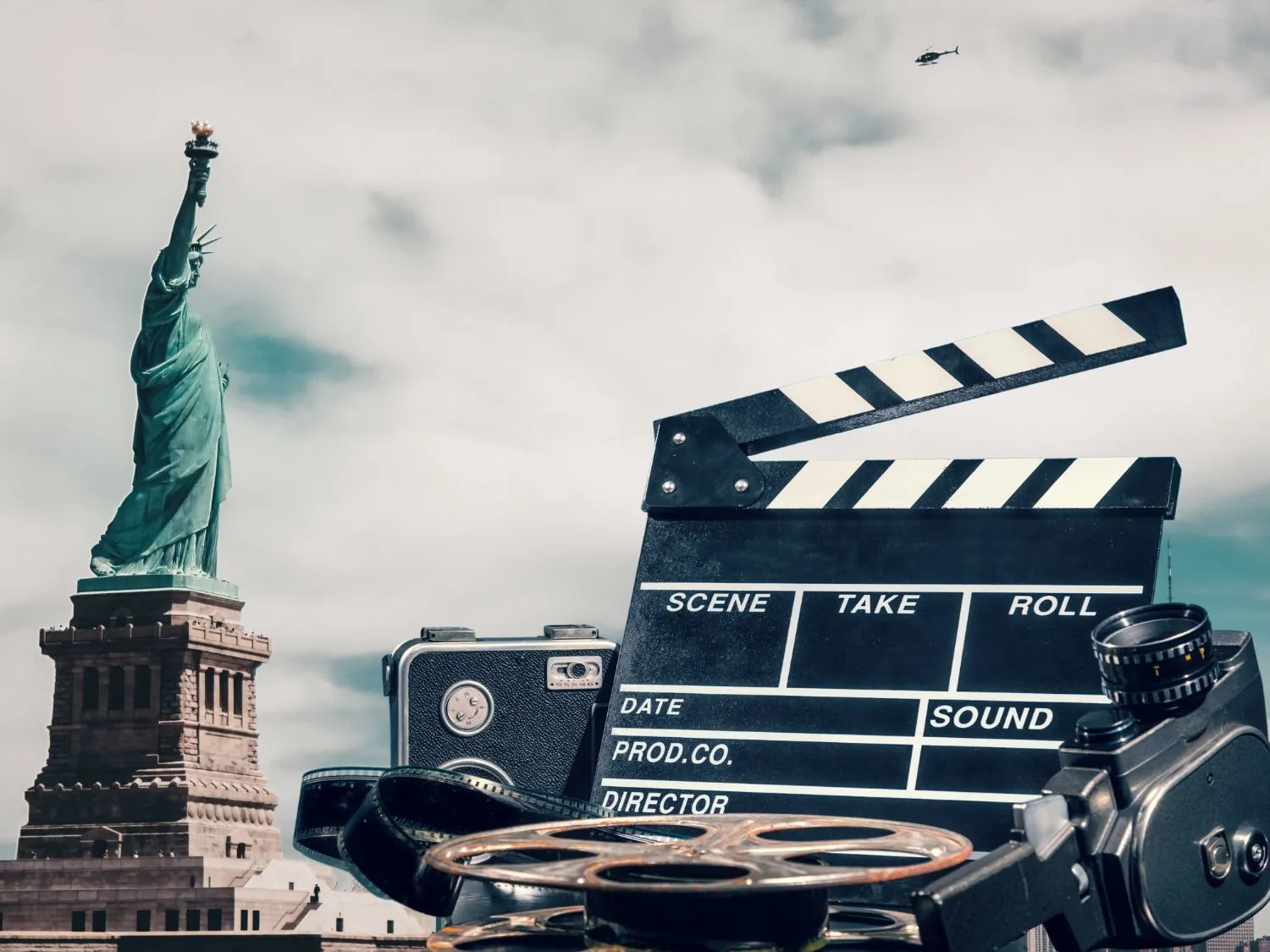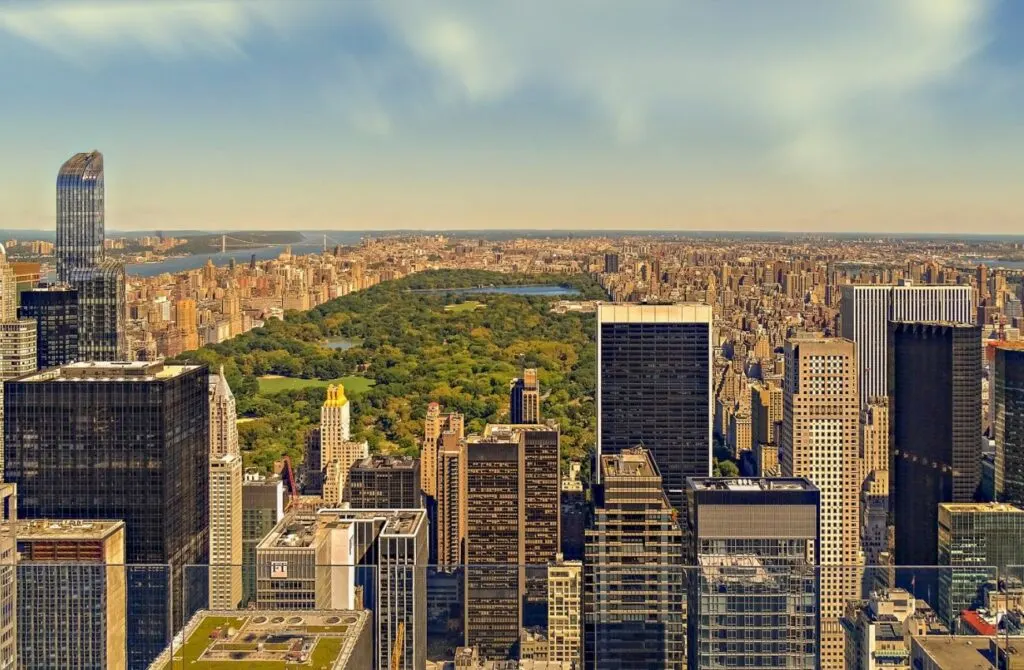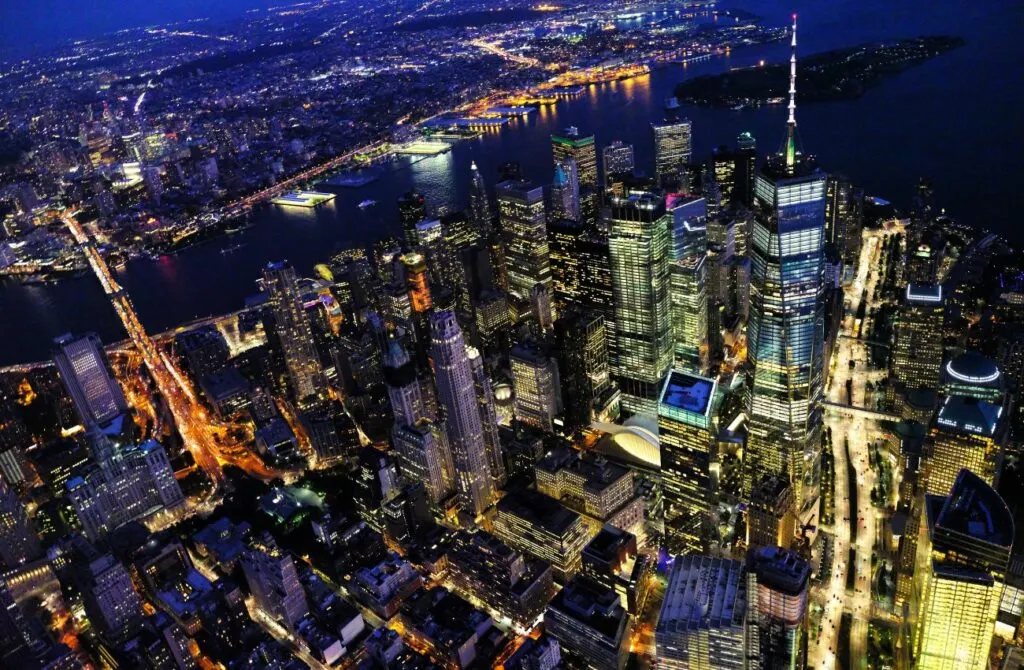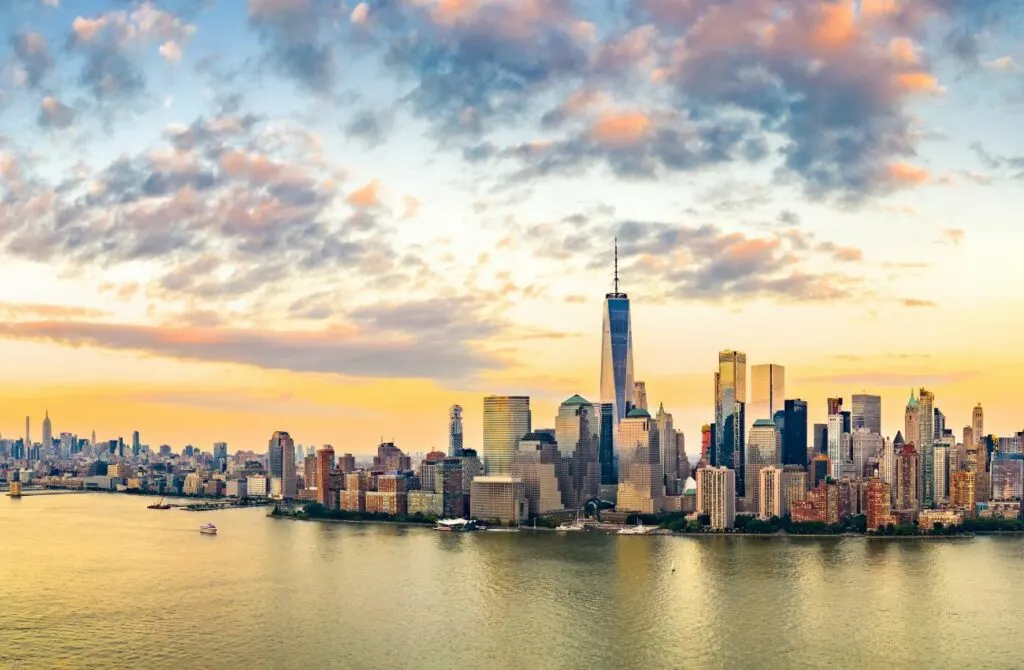Sofia De Vera combines a heartfelt passion for cinema with over 15 years of critiquing for esteemed film publications, wielding academic credentials from the University of Southern California and New York University, to serve as your personal guide through the enchanting worlds of film and television. Her full guest bio can be found here.
There are certain special cities across the United States that have managed to cultivate their own enigmatic atmosphere and culture. New York City is one of those cities, and movies set in New York City typically manage to translate the unique atmosphere within the city to the big screen in a way that few places can ever match.
Sometimes that atmosphere is one of historical importance, sometimes it is this blending of different cultures, and other times it is the feeling of unhingedness and wall-to-wall excitement that infiltrates the city’s air. The only thing you can ever say for certain after watching these films is that New York City is never boring.
After all, New York City is not only a major economic and cultural center, with an important hub of air traffic, but it also has diverse streetscapes, heritage homes, a rich history, and an illustrious creative arts scene.
Although it interrupts traffic and annoys neighbors, it is clear that in New York, the filming of movies and series on its streets has a positive impact on tourism and the economy. Movies shot in New York provide well-paying jobs for New Yorkers, support local businesses, and promote the city as a tourist destination.
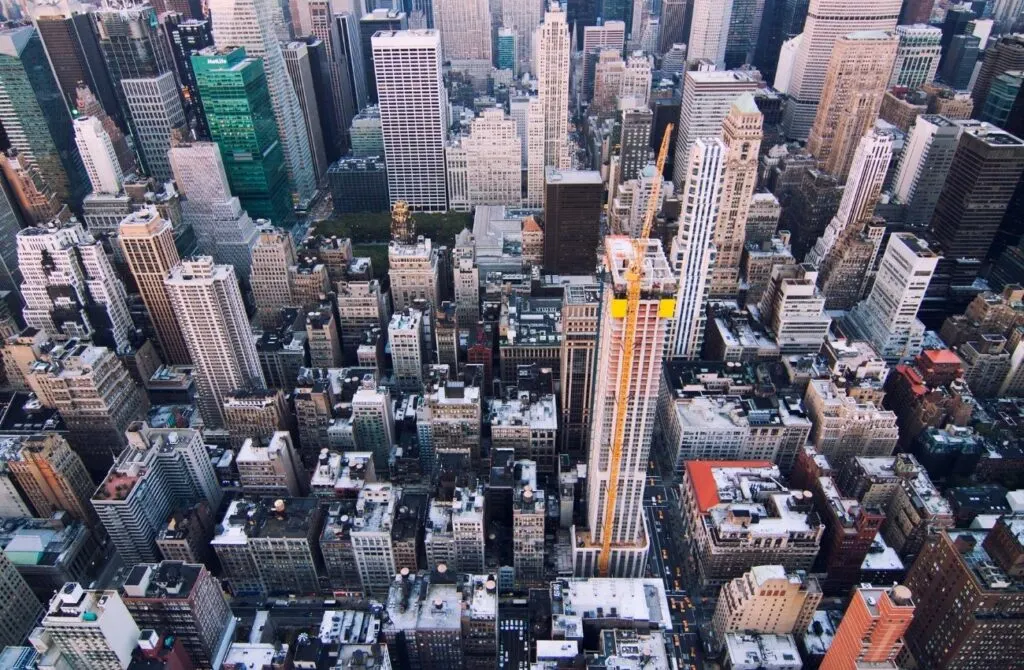
Until the sixties, filming in the city required going through up to fifty official permits. Even Alfred Hitchcock had to shoot the exteriors of the UN in 1959 for ‘Death at His Heels’ hidden in a carpet cleaning van. But in 1966, the then-mayor of the city, John V. Lindsay, seeing the benefits that the film industry generated in California, included in his electoral program the promise to turn New York into a “movie city” through the Department of Cinema, Theater, and Retransmissions, which still works today.
New York has a lot to offer for both national and international filmmakers, as it has both modern cityscapes as well as historical architecture. It is widely regarded as the cultural, financial, media, and entertainment capital of the world, so it will come as no surprise that there are so many wonderful movies set in New York.
The most famous city in the world is bound to have tons of things to offer. Even those farthest away from New York know about it: this big metropolis where dreams come true and the fate of entire cultural industries is decided.
Yet there are still many things left unsaid about the city, and films are a perfect way to express that which can’t be said. All genres of stories have been told in the city. But it still hasn’t lost its charm: modern filmmakers manage to show new things that nobody had noticed before in this place.
New York is a place with many voices that want to be heard. With each of these movies, you’ll get closer to the city and its people. By the end, you are going to know this unique city as well as the most typical New Yorker
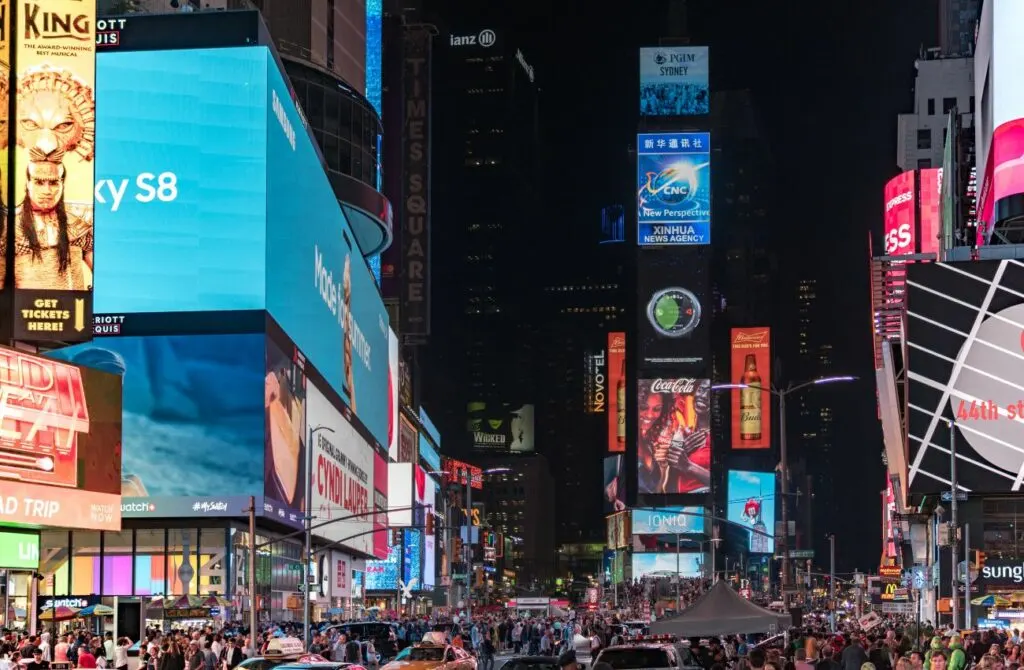
These New York films have narratives that rely on their settings as much as their main protagonists, and as a result, spectators get a glimpse of this iconic country through the director’s eyes. To honor the concept of cinematic travel, we have also assembled lists of our favorite films shot in some of our all-time favorite travel destinations: Romania, Italy, Mexico, Ireland, Australia, Japan, Alaska, and Israel.
Wondering where to watch? It depends on where you live in the world and which streaming services you have. We link to the streaming service we watch on in each case - be it Netflix, Amazon Prime, Apple TV+, or elsewhere.
You can get one month free of Amazon Prime (or a 6-month trial for students) of Amazon Prime and also get immediate access to FREE Two Day shipping, Amazon Video, and Music. While you won't be charged for your free trial, you'll be upgraded to a paid membership plan automatically at the end of the trial period - though if you have already binged all these, you could just cancel before the trial ends.
Apple TV+ also has a one-week trial, and Hulu has a one-month trial (which can be bundled with Disney!). Another option might be using a VPN to access Netflix titles locked to other regions. Netflix is now available in more than 190 countries worldwide and each country has a different library and availability. US Netflix is (understandably) one of the best.
While we wish everything could just be in one place - for now, it seems these are the best streaming platforms to watch on.
Page Contents
- The Godfather (1972)
- Goodfellas (1990)
- Rear Window (1954)
- Ghostbusters (1984)
- Spider-Man (2002)
- Moonstruck (1987)
- When Harry Met Sally… (1989)
- West Side Story (1961)
- Uptown Girls (2003)
- Frances Ha (2012)
- Do the Right Thing (1989)
- Birdman (2015)
- The Devil Wears Prada (2006)
- Autumn In New York (2000)
- The Age Of Innocence (1993)
- Annie Hall (1977)
- Midnight Cowboy (1969)
- Taxi Driver (1976)
- Kramer Vs Kramer (1979)
- Gangs Of New York (2002)
The Godfather (1972)
The overarching and profound influence that The Godfather has had on cinema from all over the world can’t be understated. This film, together with its two sequels (one in 1974 and another in 1990), is a landmark in the crime genre, and the filmmaking techniques used in its making have been applied in all kinds of films.
The Godfather tells the story of the Corleone crime family, who are not the most powerful but do have a lot of push in the local mafia politics. Its most notable members are Vito Corleone (Marlon Brando), the don and head of the family, and his son Michael (Al Pacino).
Filmed almost exclusively in New York, the film treats the city like a character, depicting every inch of its streets, of its people, with just the right historical buildings as a backdrop for the crime drama.
When the real-life building wasn’t appropriate, the production department built one, taking into account that it would have to fit seamlessly in the New Yorker Landscape. The film wouldn’t be the same if it were set in another city. There isn’t a better way to experience New York in 1945 than through The Godfather.
Goodfellas (1990)
If The Godfather was the foundational film for the crime and gangster genre, this film takes this style to its greatest expression. Another classic New Yorker film directed by Martin Scorsese, this time the story of crime and darkness goes beyond fiction. Goodfellas is based on the book Wiseguy, which chronicles the life of infamous mob associate, and later FBI informant Henry Hill.
It´s a story that belongs in 1950s Brooklyn, when a young Hill (Ray Liotta) began working for a local Italian-American mobster and met those who would become his allies in the times to come: Jimmy Conway (Robert De Niro) and Tommy DeVito (Joe Pesci). The three of them rise to the top of the New York crime food chain, but that’s when things get harder than ever: they become targets, both of the other mobsters and of the FBI.
Goodfellas doesn’t paint the prettiest picture of New York, but one can’t deny that it’s a love letter to its most hidden side. The entire film takes place in the city, with a great part being set in many different locations where crimes can be hidden away.
Yet the film’s most iconic shot is not in one of these locations: the long shot that takes Henry and his date from the car in the street to their table at the Copa Long nightclub, going all the way through the kitchens without cutting away. The shot was filmed in the famous New York cabaret known as Copacabana, with has been a staple of the city’s nightlife ever since the 1940s.
Rear Window (1954)
One of Alfred Hitchcock’s most famous films, Rear Window takes place in one of the many apartment buildings found in Greenwich Village, Manhattan. Beyond all its significance in popular culture and the cinematic proficiency with which it was made, the film is actually very entertaining.
More than fifty years later, the stories that Hitchcock told still manage to move us. With a filmography as good as Hitchcock’s, it’s no little thing to say that Rear Window is regarded as one of his best.
The film tells the story of L. B. Jefferies (James Stewart), a photographer who was in an accident and has been bound to a wheelchair for a time. Alone in his apartment in New York, he has taken to watching his neighbors through the window.
This voyeuristic hobby turns sour when, after hearing a woman scream, he sees one of his neighbors coming and going sneakily through the courtyard.
Worried for his neighbor’s wife, Jefferies enlists his friend Lisa (Grace Kelly) in his attempt to discover the mystery of the scream. Rear Window tells a tense story that will keep you on the edge of your seat while never leaving that iconic apartment in New York.
Ghostbusters (1984)
The original Ghostbusters is regarded as one of the funniest films ever made. Though lots of people remember it to be a wacky comedy about trapping supernatural entities, it’s actually a very smartly written film, with many jokes that surely went over the heads of the kids and teenagers that watched it when it was released.
Starring the film follows a group of parapsychology professors that finally stumble upon a supernatural phenomenon, which gets them fired from Columbia. While Egon (Harold Ramis) and Ray (Dan Aykroyd) want to continue to investigate, Peter (Bill Murray) thinks that this is their perfect opportunity to get rich.
They establish the Ghostbusters, ghost exterminators that will end up saving the whole city from annihilation.
A popular tourist spot in New York, the fire station where the Ghostbusters set up their headquarters can be found in the neighborhood of Tribeca: fans constantly visit 14 North Moore Street in order to take a picture with the iconic station, which is still working today.
The ghostbusting phenomenon is so big that the station now bears a Ghostbuster badge on its front. Any fan of action comedies will surely enjoy this comedic masterpiece.
Spider-Man (2002)
This iconic superhero movie paved the way for the more modern takes on the genre that can be seen in the last decade and a half. Spider-Man sees director Sam Raimi, who before had only worked on horror and thriller films, tackling one of the most famous comic book characters ever: the nerdy boy from Queens who’s bitten by a genetically-modified spider and thus becomes a superhero.
This story, that resonated so much with comic book readers, hadn’t found much success beyond the pages. It wasn’t until 2002 Spider-Man that the whole landscape of action-adventure blockbusters changed.
Set in New York City, Spider-Man follows Peter Parker (Tobey McGuire) as he tries to find his way in high school and, after being bitten by a “super-spider”, then tries to find his way as a superhero with powers like no other.
Like Spider-Man himself, the film is New Yorker through and through. The home where Peter lives with his uncle and aunt it’s a real house from Queens, his hometown. Of course, Peter and his classmates visit Columbia University, a staple of the city’s educational and intellectual activities, being one of the best schools in the world. One of the city’s most famous buildings is featured in the film: the wedge-shaped Flatiron Building, where the offices of the Daily Bugle are located.
Moonstruck (1987)
This wonderful romantic comedy sees Cher falling in love with a young Nicholas Cage in a story about romance, family, and tradition. If you’re not so sure about Cher’s acting chops, you should totally see this movie.
Her performance as Loretta Castorini earned her an Academy Award for Best Actress (the film also won Best Original Screenplay). Moonstruck was directed by the talented Norman Jewison, who was also behind several other celebrated films, like In the Heat of the Night and Fiddler on the Roof.
The film tells the story of Loretta (Cher), a widow in her thirties who gets proposed to by her boyfriend who’s about to leave for Sicily. She accepts, only with the condition that they follow Italian tradition strictly.
And so, Loretta finds herself personally inviting her boyfriend’s estranged brother to the wedding. Yet, as she gets to know Ronny (Nicolas Cage), she finds that maybe this is the brother she should be with.
Moonstruck is a film deeply embedded in the culture of Italian descendants living in New York. There are many scenes that stand out as truly representative of the city, but Loretta and Ronny’s opera date at the Lincoln Center for the Performing Arts is definitely at the top of the list.
When Harry Met Sally… (1989)
Directed by Rob Reiner and written by Nora Ephron, experienced creatives in the art of romance stories, When Harry Met Sally… is one of the best romantic comedies ever to be made.
This film famously poses the question of whether men and women can be friends and, by the end, doesn’t quite give an answer to that. Still, the journey that we take through this film makes the latter parts become much more touching and moving. It’s a film that, by the end, it’s sure to put a smile on your face.
Set in 1997, the film follows Harry (Billy Crystal) and Sally (Meg Ryan), two graduates of the University of Chicago who are on a ride to New York. This is the first time they met, and it doesn’t end well. Yet fate would have it so that they would meet again and again, leading them to develop a friendship, and then something more…
One of the most iconic spots in New York film tourism is Katz’s of New York City, a delicatessen where Harry and Sally have lunch and she, famously fakes an orgasm. The famous line by Estelle Reiner, “I’ll have what she’s having”, can be found in a sign hanging over the very table where the scene was filmed.
West Side Story (1961)
A tragic tale retold; West Side Story is a romantic drama musical that brought a whole new level of entertainment to the genre. First conceived as a Broadway musical in 1957, it was created by Jerome Robbins, a famed dancer, and choreographer, who took inspiration from Romeo and Juliet to craft this captivating story.
For the making of the movie, Robbins collaborated with the outstanding Robert Wise. The result was an outstanding film that won ten Academy Awards, the most wins ever for a musical.
Set in the 1950s, the film tells the story of two rival gangs in West Side New York. While the Jets dare the Sharks to fight after an upcoming dance, Jets co-founder and ex-member Tony finds himself falling in love with Maria, who is sister to the leaders of the Sharks.
You’ll have to find out whether these star-crossed lovers meet a fate as tragic as Romeo and Juliet, or not. West Side Story is truly a New Yorker film. The film’s essence is embedded in this city. In fact, the standout scene in the movie is the love declaration, which happens in an iconic New York fire escape next to Maria’s window.
Uptown Girls (2003)
This comedy movie from the 2000s had a very bad reception by critics and audiences alike, yet now stands as one of the best of the decade.
The story of Uptown Girls, directed by Boaz Yakin, follows Molly Gunn (Brittany Murphy), the daughter of a dead rock legend and inheritor of his huge wealth, who suddenly finds herself penniless and completely lost due to an embezzling committed by her accountant.
This is how Molly becomes a nanny for “Ray” (Dakota Fanning), an eight-year-old who’s a little neurotic, as well as a little bit of a hypochondriac. At first, Ray is completely closed off from everything not orderly. Yet Molly is dedicated to showing Ray how to have fun.
The title of Uptown Girls refers, of course, to the uptown of Manhattan, where one can find the most elegant and rich places in New York. While there are plenty of Uptown sights in the film, the most interesting place shown is the Bow Bridge, which crosses the beautiful lake at Central Park.
Built entirely out of cast iron, the bridge is one of the most stunning sights that can be found in the whole park. In the film, it’s seen in the scene where a desperate Molly visits and ends up jumping into the lake.
Frances Ha (2012)
Frances Ha is a comedy-drama film that tells a fascinating story of a struggling dancer that carries some good punches. The film didn’t have the most uproarious of welcomes, but it was indeed praised by critics and liked by audiences. It wasn’t until several years later that the film would garner the cult following that it has today.
This is, in part, due to the career that its director and actress had after it. It’s true that Noah Baumbach had a long career before Frances Ha, but it wouldn’t be until Marriage Story that he would become renowned. The same goes for his partner (both in life and in writing), Great Gerwig, who wouldn’t see huge success until the release of Lady Bird and Little Women.
Set in NYC, the film follows the life of Frances Halladay (played by Gerwig), a struggling dancer about to turn thirty who learns that her roommate and best friend, Sophie (Mickey Sumner), is moving with her boyfriend.
This means that Frances would be living alone in her Brooklyn apartment, but she doesn’t have enough money to pay the rent on her own. Angry with Sophie, the film sees Frances relocating to Chinatown and trying to get her life together once and for all.
Do the Right Thing (1989)
Do the Right Thing is a comedy-drama film entirely created by the extraordinaire filmmaker Spike Lee. He not only wrote, produced, and directed the film, but he also acted in it.
The film follows Lee’s character, Mookie, as he delivers pizzas in a racially tense Brooklyn neighborhood. As the film goes by, we get to meet the picturesque residents of this place and get a sense of what binds them together as a community. By the end of this film, this community will be shaken by several tragedies.
The movie is set on Bedford-Stuyvesant, a neighborhood in Brooklyn with a very high percentage of African-American population. The place where Jay-Z was born, Bedford-Stuyvesant had never been portrayed in a film before: it’s not only the neighborhood, of course.
Do the Right Thing is a provocative film that founded a whole new way for African-American creatives to express their own life experience. And it did so at a time when racial tensions were still high. Spike Lee managed to tell an enchanting story while, at the same time, painting a vivid picture of what black New Yorkers go through in their day-to-day lives.
Birdman (2015)
Does the latest film by Alejandro González Iñárritu have a plot? Yes, of course, it does. And it’s very simple; it’s not even particularly original: a former movie star wants to redeem himself from his Hollywood past by editing, directing, and starring in a serious play.
The preparations for the play will serve so that, in a series of catharsis, the protagonist understands himself and the life that surrounds him. What? Forty-five words. It’s been forty-six, and that’s not a plot; it’s not even a synopsis.
The protagonist is Riggan Thomson, a former Hollywood actor who, in his sixties, wants to prove to the world that he is not only the star of a series of superhero movies from twenty years ago – the eponymous Birdman – but that he is an actor of truth. A theater actor. From Broadway. And the work that he adapts is neither more nor less than What We Talk About When We Talk About Love by Raymond Carver. Intimate, deep, serious.
Without artifice or concessions, a galaxy away from the blockbusters that Thomson has played. So true that critics have never been able to find a misinterpretation of it. The lead actress in the play is a Hollywood actress in her prime, but she is as excited as she is terrified to perform on the Broadway stage. The second actress is Thomson’s new partner, whom the protagonist treats like an annoying mosquito.
Something similar can be said of Thomson’s daughter, a recently recovered addict who acts as her personal assistant, or even the theatrical producer, practically the only friend of the protagonist and who will do everything possible to make the play come to fruition.
The protagonist in Birdman is Michael Keaton, a sixty-three-year-old Hollywood actor who plays a Hollywood actor who wants to be a stage actor, whom almost everyone knows for having been Batman two decades ago. The second actor is Edward Norton, one of the best-regarded performers by world critics. Of the few of his generation that he is a real actor, and that he plays a real actor; but that, on the other hand, he was The Incredible Hulk.
The first actress is Naomi Watts, with the wrinkles of fullness. Her daughter is Emma Stone, cynical and unbelieving. She is too self-aware for her age, too hurt to believe in parents, much less in superheroes. Are you talking about Stone or her character? From her character, Stone has been Spiderman’s girlfriend for nothing. And the producer is Zach Galifianakis, so often stupid and hungover, but here he is the only sensible and focused character in the film.
The Devil Wears Prada (2006)
It has been 15 years since The Devil Wears Prada was released, an important film in Anne Hathaway’s career that was part of her transition from teen comedies to dramas and other somewhat deeper genres. The film came shortly after Brokeback Mountain, in which her character Anne had her first dramatic steps that managed to grab the attention of many.
Just a couple of weeks ago, on the occasion of her anniversary celebration, some details behind the production were revealed, such as the fact that Hathaway was not the favorite for the role, but with her insistence and the support of Meryl Streep, she managed to get it. The film covers the theme of fulfilling your job dream, showing that it is not an easy path; Broadly speaking, it seeks to point out that it is not worth losing everything in order to get your ideal job.
But despite this, it is still present that after everything she lived in that fashion editorial, the protagonist achieved maturity and returned to the right path, implying that this is how things should be. Without a doubt, the film, as commercial as it may seem, has many things to reflect on, such as the fact that Andy’s boyfriend is not empathetic and only thinks of himself, or that his friends criticize her for giving him priority to their duties, but still receive their gifts with excitement.
Autumn In New York (2000)
Autumn in New York is a 2000 American film directed by Joan Chen and starring Richard Gere, Winona Ryder, and Anthony LaPaglia. The film, along the lines of Love Story, tells of the mature Will Keane (Richard Gere), who falls in love, perhaps for the first time, with the young and sensitive Charlotte (Winona Ryder), a woman who is the daughter of his old flame, who discovers that she is seriously ill with neuroblastoma of the heart.
Will Keane, a forty-eight-year-old restaurant owner, can’t seriously bond with a woman, so when he meets Charlotte Fielding, a carefree girl half his age, he imagines another easy story. But nothing about their relationship will be pointless and venial. When the time comes for Will to decide to end the relationship, Charlotte confides in him that her story, in any case, could not have lasted since she is dying of cardiac neuroblastoma.
Although Charlotte’s grandmother is not thrilled about her romance, she asks Will not to abandon her granddaughter at such a tragic time. In fact, the grandmother does not want her granddaughter to stay as she did to her daughter with the same man: Will is in trouble, caught between his own fears and some kind of moral duty. The only person who doesn’t seem concerned about such a situation is Charlotte herself, who has taken her illness philosophically and has no intention of fighting it, limiting herself to living to the fullest the time that remains of her. Now Will realizes that he has really fallen in love with a woman for the first time and begins an exhausting search to try to save his beloved.
In the end, also thanks to the help of his daughter, with whom he has a somewhat troubled past, Will finds a surgeon willing to operate on Charlotte, but only as a last resort. After a few collapses, Charlotte suffers the decisive blow; she is hospitalized and operated on, but the conditions are too severe, and therefore, in the end, she dies. For the first time, Will is left alone, but to his rescue comes the newfound daughter, who also makes him a grandfather.
The Age Of Innocence (1993)
Often, the veneration for a certain director provokes certain prejudices in his admirers. Prejudices that prevent the evaluation of some submissions, far from the usual in appearance, and automatically considering them ridiculously inappropriate for the personality of the artist in question.
When Scorsese announced that he would be adapting Edith Warthon’s novel ‘The Age of Innocence’ (for which he would win the Pulitzer Prize in 1921), many were quick to express their displeasure, as if the Italian-American filmmaker was only capable of brilliantly filming bloody and dizzying gangster dramas, and as if this decision responded more to a need to seek prestige and less to a personal and creative impulse.
But if Scorsese is the great filmmaker that so many revere, it is also because his personal universe is not restricted by genres, themes, or labels, but rather is influenced, amplified, and enriched by an insatiable cultural and intellectual curiosity that constantly presses on his ideas and artistic limits, then expands them.
The truth is that it had been a long time Scorsese had wanted to dive into a story of these characteristics, and Wharton’s novel was ideal for him for many reasons. Born into an aristocratic New York family, Wharton was groomed from an early age to become a distinguished lady of high society. But her exciting life completely cuts her off from that destiny.
The Age of Innocence is an accurate and implacable portrait of a universe closed in on itself, whose laws prevent the natural expression of feelings and whose creeping participants find pleasure in all kinds of rumors and gossip, judging others, getting into their lives and in their personal relationships. Its credit titles, created for the third time by Elaine and Saul Bass for Scorsese, exemplarily contextualize the theme of the film, with a succession of flowers of different colors, which we see through a filter with Victorian calligraphy or lace.
The successive blooming of the flowers reveals that lace, that filter that seems to capture them. The obvious metaphor of the fight against the repression that Madame Olenska and Newland Archer, with their secret relationship, carry out. But all the scenery, the meticulous detail, are aimed at representing a sublimation of the superficially luxurious against the urgency and anguish of unstoppable passion.
Annie Hall (1977)
Of all the collaborations between Woody Allen and Diane Keaton, which began in 1972 with ‘Sueños de seductor,’ perhaps the most intimate is Annie Hall, a work that draws on the lives of both when they had a fruitful emotional and artistic relationship.
The boundary between fiction and reality is as blurred here as in a fictionalized and metatextual autobiography by Vladimir Nabokov. Not in vain, the leading couple meet during a tennis match, one of the great hobbies of the author of Look at the Harlequins, and the central theme of ‘Match Point,’ the latest film by the American director. Woody Allen conceived the character of Annie Hall as a copy of his sentimental partner.
Suffice it to note that Diane Keaton’s original last name is Hall, and that Annie is a pet name that her closest friends know her by. Also, before being an actress, Diane Keaton worked in nightclubs as a singer, as in the film. In a parody game, the character played by Allen is called Alvy Singer, as if he were emulating one of those clever anagrams so characteristic of Nabokov.
‘Annie Hall’ was so successful at the time of its release that it became a mass phenomenon. Diane Keaton brought her own clothing to her character, creating fashion. In this way, the vest, the tie, the baggy pants, and the fedora hat began to be exhibited in the windows of the chicest stores on Fifth Avenue. In these fineries, he seemed the reincarnation of George Sand, a temperamental and independent character who astonished Parisian society with his manly demeanor.
Midnight Cowboy (1969)
Two scenes that take place outside of New York allow us to define what that city is for a young Texan who is going to try his luck in the great metropolis. Despite being British, John Schlesinger made, in 1969, Midnight Cowboy, which, together with Taxi Driver (Martin Scorsese, 1976), is one of the most New York films in living memory.
Some consider it a product of the twilight western, like Easy Rider (Dennis Hopper, 1969), but in reality, it could not be more urban or more significant than a place like the Big Apple. Both close the 1960s, a controversial decade, if any, where innumerable historical events took place that had international repercussions: the fight against racial segregation, the Vietnam War, the rise of the hippie culture, the artistic counterculture, the imposition of rock music… In short, years full of meaning and abrupt changes for a society that until then lived in a bubble of naive prudery.
The opening sequence sees us as Joe Buck, a young Texan preparing to leave his country life for the big city. Dressed as a cowboy, he grooms himself, shines his boots, and leaves with a leather suitcase, where he carries his few belongings. Joe looks in the mirror, proud of his appearance. They are the best lights of him to shine in the capital.
Near the end of the film, during his transfer to Miami, Joe changes his dirty and ruined clothes. The cowboy outfit is left in a dumpster, where the leather boots that he polished with such dedication refuse to enter.
In Midnight Cowboy, New York unfolds through the windows of a multi-story hotel where Joe has arrived from his homeland; in the subway, where Joe meets Rizzo once he has been ripped off; in the filthy streets that he walks, while transvestites, prostitutes, and pederasts offer his services; in the dark movie theaters where he gets clients who require paid love, in the mansion ready to collapse in the middle of Times Square, where Rizzo welcomes him in his shelter; at the hotels on Fifth Avenue, where Joe gets kicked out, while Rizzo waits for him outside on a cold winter night, or even at the Warhol Factory party, where they both turn up for a random invitation and go out alienated…
The alienation leaves them with a desire, an escape from that harsh life that doesn’t offer them even a glimmer of opportunity. Miami is the new Promised Land, where they will go renewed in hope, but with a future as tragic as their life in New York has been.
Taxi Driver (1976)
The sequence has been honored hundreds of times, frames that make clear the influence of Taxi Driver since its premiere on February 8, 1976. Travis Bickle (Robert De Niro) looks at himself in the mirror, a shoulder holster keeps a pair of weapons on his naked torso, draws and asks his reflection: Are you talking to me?
The image quickly became an icon of the American counterculture of the late 1970s; since then, it has been recreated in other fiction, television series, t-shirts, notebooks, graffiti, and more, making Bickle one of the most popular characters in the world. His popularity is such that some have made him a hero, such as John Warnock Hinckley Jr., who, inspired by the actions of the protagonist of Taxi Driver, tried to assassinate then-President Ronald Reagan on March 30, 1981.
For the film critic Alonso Díaz de la Vega, this demonstrates the way in which the validity of the film directed by Martin Scorsese has been maintained since 1976 and how the themes behind its images have been misunderstood by a part of the public, which wishes to emulate to Travis and ignores the portrait of toxic masculinity created by Scorsese and Paul Schrader, screenwriter of the film.
It is a very contemporary film, more than in its time. So it was seen as a counter-narrative; what it did was contradict the attempt to cover up the disappointment with Nixon, Vietnam, the end of the summer of love. It is a film that, if seen today, is going to be read in a way that is closely linked to the American extreme right. It is. In the end, Travis Bickle is a representation of that kind of man.
Kramer Vs Kramer (1979)
The main characters, the wife and the husband, arouse the identification of men and women from any country in the 1970s and 40 years later, as they represent two universally valid archetypes: the woman who musters up the courage to break up with a marriage unsatisfactory, and the man who assumes, at a good time and full time, his paternity beyond his traditional role as a provider of material sustenance.
In addition to the couple and their conflicts, and the divorce, and the custody trial, Kramer vs. Kramer is one of the films whose narrative is aimed, above all, at showing the daily life of the father and his son, that is to say, that the greatest part of the scenes focuses on human warmth, the affective and filial world, the common people who are forced to grow above their customs, mental schemes and ordinary desires.
By the way, none of Robert Benton’s subsequent films had the success, the awards, the excellent reviews, or the eternal applause of the spectators as Kramer against Kramer did, which, in addition to the perceptive and emotional story about a couple in crisis and a child in the middle of the conflict, presents the histrionic competition, brilliantly exhibitionist, between a Dustin Hoffman who has become one of the most brilliant actors of his generation and an almost debutant Meryl Streep, but willing to steal from the brilliant “anti-divo,” at least, the last third of the film.
Gangs Of New York (2002)
To convince you that Gangs of New York is a great movie, suffice it to say that it was directed by Martin Scorsese and starred Leonardo Di Caprio, Daniel Day-Lewis, Cameron Diaz, and Liam Neeson.
Steven Zaillian was also the screenwriter for great movies like Schindler’s List, Hannibal, American Gangster. Next to him was Kenneth Lonergan, screenwriter for Manchester by the Sea, Analyze That. The duo captured the idea that the director had already had in mind since the 70s.
Is that, after reading the book “The Gangs of New York” by Herbert Asbury (1928), Martin did not stop imagining how to bring the story of Irish immigrants to the big screen. The book awakened in Scorsese the dream of narrating in a mega film the struggle for survival, in the midst of the American civil war and the crisis, between natives and newcomers. Scorsese revealed that one of the reasons why he took so many years to make this film was the fact that he could not decide what part of the story to tell, in addition to the world he should create.
Michael Ballhaus was director of photography. Michael is responsible for the art of films such as Francis Ford Coppola’s Dracula.
Lighting plays a very important role in the setting and in conveying the feeling of oppression. At Scorsese’s request, Rembrandt’s use of light was imitated.

